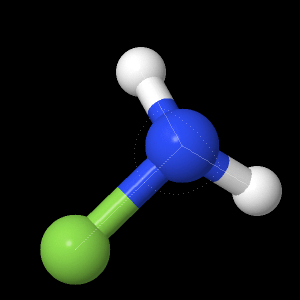NFH2
The model for the best geometry optimization is shown in a live display using the Double Zeta Valence level of theory. The DZV level of theory was best, because it used the largest basis set size. The geometry results from all the levels of ab initio theory are compared to literature values shown in Table 1.
|
|
| Table 1: Bond Lengths (nm) |
Theory |
||||
| Bond |
AM1 |
621-G |
631-G |
DZV |
Experimental |
| N-F |
0.135 |
0.137 |
0.145 |
0.143 |
* |
| N-H |
0.104 |
0.101 |
0.101 |
0.100 |
* |
The HOMO or highest occupied molecular orbital is shown in a live display using the DZV level of theory.
|
|
The LUMO or the lowest occupied molecular orbital is shown in a live display using the DZV level of theory.
|
|
The molecular electrostatic potential is shown using the DZV level of theory. This live display shows the electrostatic potential at a certain point of the molecule with red meaning a negative potential and blue meaning a positive potential.
|
|
The partial atomic charges are shown in a live display using the DZV level of theory with the corresponding value on each atom.
|
|
The dipole moments were calculated using different levels of ab initio theory compared to the literature value.
| Table 2: Dipole
Moments |
|
| Theory |
Dipole Strength (Debye) |
| AMI |
2.138298 |
| 6-21G |
2.837419 |
| 6-31G |
3.043117 |
| DZV |
3.104671 |
| Experimental |
* |
The calculated vibration energies were 1015.77cm^-1, 1255.03cm^-1, 1414.08cm^-1, 1787.08cm^-1, 3730.47cm^-1, and 3876.54cm^-1. More details can be seen by going to the Vibrational Calculations page.
HF
Anisole
Vibrational Calculations
Home Page
References
Page
skeleton and JavaScript generated by export to web
function using Jmol
12.2.34 2012-08-09 20:37 on Feb 25, 2013.
